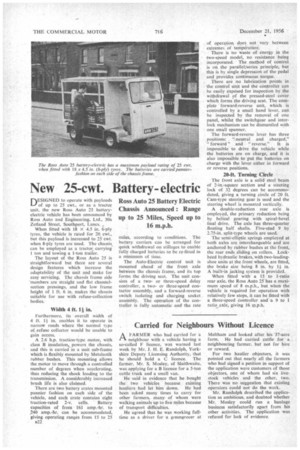New 25-cwt. Batteryelectric
Page 56

If you've noticed an error in this article please click here to report it so we can fix it.
Ross Auto 25 Battery Electric Chassis Announced : Range up to 25 Miles, Speed up to 16 m.p.h.
DESIGNED to operate with payloads of up to 25 cwt., or as a tractor unit, the new Ross Auto 25 batteryelectric vehicle has been announced by Ross Auto and Engineering, Ltd., 30a Zetland Street, Southport, Lancs. ,
When fitted with 18 X 4.5 in. 6-ply tyres, the vehicle is rated for 20 cwt., but this payload is increased to 25 cwt. when 8-ply tyres are used. The chassis can be employed as a tractor carrying' 1 ton and towing a 1-ton trailer.
The layout of the Ross Auto 25 is straightforward but there are several design features which increase the adaptability of the unit and make for easy servicing. The chassis frame side 'members are straight and flat channelsection pressings, and the low frame height of 1 ft. 6 in. makes the chassis suitable for use with refuse-collection bodies.
Width 4 it. 11 in.
Furthermore, its overall width of 4 ft. 1+ in. enables it to operate in narrow roads where the normal type of, refuse collector would be unable to gain access.
A 2.6 h.p. traction-type motor, with class B insulation, powers the chassis, and this is carried in a unit sub-frame which is flexibly mounted by Metalastik rubber bushes. This mounting allows the motor to move through a controlled number of degrees when accelerating, thus reducing the shock loading to the transmission. A considerably increased brush life is also claimed.
There are two battery crates mounted pannier fashion on each side of the vehicle, and each crate contains eight traction-rated 2-v. cells. Battery capacities of from 161 amp.-hr. to ,240 amp.-hr. can be accommodated, giving operating ranges from 15 to 25 e22 miles, according to conditions. The battery carriers can be arranged for quick withdrawal on stillages to enable fully charged batteries to be re-fitted in a minimum of time.
The Auto-Electric control unit is mounted ahead of the front axle between the chassis frame, and its top forms the driving seat. The unit consists of a twoor three-speed delay controller, a twoor three-speed contactor assembly, and a forward-reverse switch isolating and charging socket assembly. The operation of the controller is fully automatic and the rate of operation does not vary between extremes of temperature.
There is no waste of energy in the two-speed model, no resistance being incorporated. The method of control is on the parallel/series principle, but this is by single depression of the pedal and provides continuous torque.
There are no lubrication points in the control unit and the controller can be easily exposed for inspection by the withdrawal of the pressed-steel cover which forms the driving seat. The complete forward-reverse unit, which is controlled by a small hand lever, can be inspected by the removal of one panel, whilst the switchgear and interlock mechanism can be dismantled with one smAll spanner.
The forward-reverse lever has three ,positions: "-neutral and charged," " forward" and " reverse." It is impossible to drive the vehicle while the 'batteries are on charge, and it is also impossible to put the batteries on charge with the lever either in forward or reverse positions.
20-ft. Turning Circle
The front axle is a solid steel beam of 2-in.-square section and a steering lock of 32 degrees can be accommodated, giving a turning circle of 20 ft. Cam-type steering gear is used and the steering wheel is mounted vertically.
A double-reduction rear axle is employed, the primary reduction being by helical gearing with spiral-bevel final drive. The axle has three-quarter floating half shafts. Five-stud 9 by 2.75-in. split-type wheels are used.
The semi-elliptic springs employed at both axles arc interchangeable and are anchored by rubber bushes at the front, the rear ends sliding on rollers. Lockheed hydraulic brakes, with two-leadingshoe units at the front wheels, are fitted, the brake size being 8 in. by A built-in jacking system is provided_
When fitted with a 15 to 1-ratio rear axle, the Ross Auto 25 has a maximum speed of 8 m.p.h., but when the vehicle is required for operation with relatively few stops, it can be fitted with a three-speed controller and a 9 to 1 ratio axle, giving 16 n.ph.




























































































